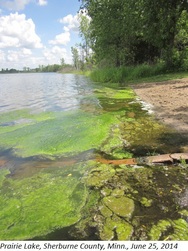 St. Paul,
Minn. – A dog died last weekend after
swimming in a Sherburne County lake that had developed areas of heavy algae
growth, according to the Minnesota Pollution Control Agency.
Last weekend,
Brock Tatge and his family, who live on Prairie Lake in Sherburne County, were
enjoying a beautiful Sunday on the lake when their dog, Copper, suddenly became
very ill. Copper had been fetching his tennis ball from the lake, one of his
favorite games.
“We noticed that
Copper went on shore, began vomiting and panting very hard, and just looked
very sick,” Tatge said. “I carried him
to my truck and brought him to the vet’s office.” Sadly, Copper’s condition
deteriorated and he died at the veterinarian’s office. While the cause of Copper’s illness has not been
confirmed, the veterinarian who examined him believed that he became ill after
ingesting toxins from blue-green algae.
The MPCA is advising
pet owners to check water conditions when dogs are playing near lakes or
slow-flowing streams. Blue-green algae “blooms” have a thick, cloudy appearance
that can look like green paint, pea soup, or floating mats of scum. Some, but
not all, species of blue-green algae contain potent toxins that can be
deadly to dogs, livestock, and other animals within hours of contact.
In this case, though most of the visible algae on Prairie
Lake was not blue-green algae, MPCA staff found some blue-green algae mixed in
with the more benign species.
If possible, dog owners should keep their pets away from
algae-laden water entirely. If animals do enter water with heavy algae growth, they
should be hosed off right away, before they have a chance to lick themselves
clean. Animals become ill when they ingest the toxins, so preventing them from
drinking affected water or licking toxins from their coat is key to preventing illness.
If someone is concerned that their pet has been exposed to
harmful blue-green algae, they should take the animal to a veterinarian
immediately.
Blue-green algae blooms can occur anytime during the summer,
though they are normally associated with warm weather and low rainfall. Algae are a natural part of the ecosystem, but
under certain conditions, algae populations can “bloom” with dramatic growth. Most
blue-green algae are not toxic, but there is no way to visually identify
whether a particular bloom contains toxins that are harmful to people or
animals.
Algal blooms occur
when lakes develop high levels of nutrients such as phosphorus. “This year’s
unusually heavy rainfall has carried tremendous amounts of nutrients into
Minnesota lakes,” said MPCA scientist Steve Heiskary. “If the rain slows down
and we move into a period of hot, dry summer weather, we could see an exceptional
number of algal blooms across the state in the coming weeks, even in lakes that
do not normally experience them.”
The best way
to prevent algal blooms over the long term is to reduce the amount of nutrients
that run off into lakes from fertilizers and organic materials like leaves and
yard waste. Once a bloom has developed, there is no way to correct it. Blooms
often come and go quickly, so the best option is to stay away from the water
until rainfall, wind shifts, or cooler temperatures disrupt the algae’s growth.
If humans are exposed to toxic blue-green algae, they can
experience skin irritation, nausea, and eye, nose, and throat irritation.
People should never swim in water if they suspect a blue-green algae
bloom. Human deaths from exposure to
blue-green algae are extremely rare, since the unpleasant odor and appearance
of a blue-green algal bloom tend to keep people out of the water.
More information on harmful blue-green algae can be found at
http://www.pca.state.mn.us/zihy141d.
|